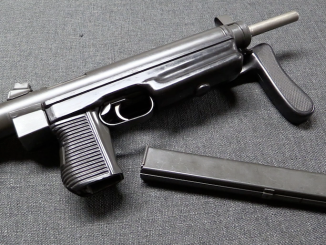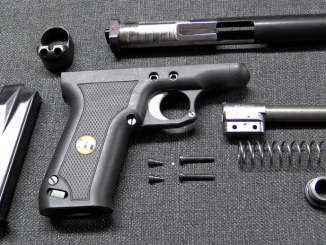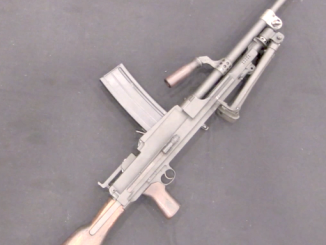In the 1970s, South Africa began looking for a domestic-production GMPG to replace its inventory of FN MAG machine guns. The MAG was an excellent weapon, but the ones in South Africa were getting old and worn out, and with the country under international embargo over Apartheid, new guns and parts were not available from FN.
The SS-77 (named for its two designers, Richard Joseph Smith and Lazlo Soregi) began development in 1977, with initially prototypes built by Lyttleton Engineering Works in 1978. The design took elements from several other excellent machine guns – the side-locking action form the SG43 Goryunov, the barrel release and feed mechanism from the MAG, and the gas system from the PK. After an extensive series of testing and tweaking, the gun was formally adopted by the South African Defence Forces in 1986, and went into serial production. Despite the development cycle, the guns still proved to have significant problems in the field. The gas piston was liable to break, along with problems of broken extractors, loose pins, and other issues. The guns were actually recalled from military service and rebuilt in the early 1990s. Following that redesign program, the gun has proven very reliable and successful in service.
A Mini-SS design was also adopted, essentially the same gun scaled down to 5.56mm. Initial plans were to produce a conversion kit to allow the regular SS-77 to use either caliber, but these were never actually produced.
0:00 Introduction and history of South African machine guns
1:37 Designing and testing of the Vector SS77
3:33 Features, feeding options, and attachments for the Vector SS77
5:46 Disassembling the Vector SS77 and its various parts
10:44 Detailed look at the action and bolt of the Vector SS77
13:30 Examination of the receiver and firing pin of the Vector SS77
14:41 Issues, redesign, and production of the Vector SS77
16:33 Introduction to the mini SS machine gun and rarity of Vector SS77
17:30 South Africa’s economic embargo and its impact on the weapon’s export market
18:00 Wrap up, appreciation of the Vector SS77’s design, and thanks to viewers




what model AOG. did you use at the Finnish games ?
The feed mechanism of the MAG was in turn taken from the MG42.
The only crew-served MG I have any real familiarity with is the MAG, and although familiarity has give me a healthy respect for that design I also find it very telling that two of the militaries with arguably the most experience carrying MAGs into no-shit combat— the IDF and the South Africans— both developed a significantly lighter system when the time came to adopt a replacement.
The third military with a LOT of MAG experience of course being the United States, which has also transitioned to a much lighter system, the 240L (240B was 27.3lbs and the 240L is about 21) albeit of the same design.
We are just now this year getting ersatz 240Ls in battalion, they’re our old 240B receivers with new barrels and stocks sent down from Crane— the weight savings are likely not so great as all that since so much of the MAG’s mass is in that burly milled receiver. I have not had the chance to get any trigger time with one yet, but I’ve enough 240B in my life so far to know I vastly prefer sitting behind one on T&E in a fighting position to lugging it around over hill and dale.
At least one of the Ranger officers who was involved in the fielding of the M240 as the replacement for the M60 had absolutely no idea at all that the M240 was the MAG58, and the same gun the Israelis and South Africans found too heavy in the bush… For what that’s worth. He genuinely thought that the M240 was strictly a coax gun in service with the United States, and that we were the only people using it…
Which baffled me, because the guys at FN had been trying to sell the Army a ground-mount kit for the M240C, the coax and tanker version since ferfreakin’ ever…
I was a bit shocked when I learned that, after asking how they chose the M240 when all these other armies had found it to be too heavy in light infantry operations. Cue look of incredulity, and the guy going “Wait… What? You’re saying the M240 is the same gun the Brits use? The Israelis? I didn’t know that…”
I want to believe someone else in the process knew all that, but… I dunno. The people running things in the Army have their moments of incredible density.
And, frankly… I think the M240 is a great gun, but I wouldn’t want to be the poor schmuck humping that bitch through the woods and over hill and dale. I mean, if I were still 20, maybe I’d feel more enthused about that prospect, but today? Nuh-uh. Just… No.
Kirk, it’s good to see you’re still around and posting. I’ve been doing quite a bit of browsing on this site recently, including on older pages, and I’ve come across a number of your comments that have been very informative. The most interesting for me have been the ones on the deployment and use of machine guns, like your posts all the way back in the article on the BAR M1918, if you remember those. I’m writing a science-fiction military series right now, and some of what I’ve learned from you has made it into my writing. I’m sure what I know about the military counts for nothing compared to all there is to know, but I try to do my research, and it’s always nice to have some tidbits that most people don’t know about, which you’ve certainly provided for me.
well not really a replacement, rather a supplement in both cases, as both SADF and IDF still have FN MAG in service. And since Apartheid ended South Africa can buy spare parts again. Probably cheaper than manufacturing the SS-77 domestically as well.
Makes me wonder if they ever tried to export the SS-77 after not being a pariah country anymore?
^^^
this was supposed to be an answer to jian’s post from OCTOBER 16, 2023 AT 6:13 AM.
Wow that is a real mechanical marvel. I guess the question is if you have the industrial capability to engineer and produce this weapon, why not just make replacement parts for the SA MAGs?
Any weight savings is extremely desirable if you use the MAG in the infantry role and especially if you do a lot of foot patrolling in difficult terrain and climatic conditions like the SADF was during the Bush War. I think the MAG is a terrific GMPG but its great vice is that it’s heavier than sin and after a few miles through dense south Mississippi brush in the high heat of summer you really start to feel every single pound.
makes sense
As well, reverse-engineering a weapon is sometimes way more expensive than just designing from scratch. Plus, there are the royalties you’d have to worry about eventually paying, same way as the US had to pay Mauser after WWI. Patent law knows no sides in a war or an embargo; FN would have gotten their own back, somehow.
On top of that, were the guys in South Africa to have started producing FN weapons, someone would have blamed FN and gotten their knickers in a twist over it all. Even if FN had nothing to do with it, the optics would have been bad, and then that’d have pissed off FN anyway. So… Smart money says “Roll your own…”
As well, why produce something you can’t sell on, yourself? Say that the South Africans were to reverse-engineer and sell copies of the FN MAG. Now what? Oh, yeah; someone is going to come after them for their share of the profits, and that’s going to be ugly for both the South Africans and the buyers.
All told, a completely South African product had rather more going for it. Aside from the lighter weight and South African design inputs unique to their experience…
I suppose all the above could be right. I’m just considering that at that point SA had already been embargoed by the whole civilized world. Their assets abroad were frozen and most first tier countries had already broken off diplomatic relations.
It would seem that navigating the finer points of patent law were the least of their worries on the world stage at that particular moment in time.
A lighter weapon overall makes sense.